 In development since 2010, Boeing’s CST-100 Starliner space vehicle lifts off atop an Atlas V rocket on its first flight, scheduled to take it to the International Space Station. A software and sensor mishap after second stage separation results in the vehicle putting itself into an orbit unable to reach the station, after burning enough fuel to make a major orbital correction impossible. Boeing and NASA settle on an alternate flight plan to allow for other engineering tests in orbit before the vehicle’s planned return to Earth on land a few days later. There is no crew aboard for this first flight, though Boeing contends that astronauts aboard might have been able to override the engineering problems that resulted in the incorrect orbital insertion.
In development since 2010, Boeing’s CST-100 Starliner space vehicle lifts off atop an Atlas V rocket on its first flight, scheduled to take it to the International Space Station. A software and sensor mishap after second stage separation results in the vehicle putting itself into an orbit unable to reach the station, after burning enough fuel to make a major orbital correction impossible. Boeing and NASA settle on an alternate flight plan to allow for other engineering tests in orbit before the vehicle’s planned return to Earth on land a few days later. There is no crew aboard for this first flight, though Boeing contends that astronauts aboard might have been able to override the engineering problems that resulted in the incorrect orbital insertion.

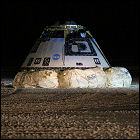 Boeing’s CST-100 Starliner space vehicle ends its uncrewed maiden voyage by successfully landing with its combination of parachutes and impact-cushioning airbags at White Sands, New Mexico. Intended to visit the International Space Station on its first flight, the Starliner’s flight plan changed unexpectedly when a software and sensor mishap during launch put it into the wrong orbit, and used more fuel than expected, making it impossible to reach the same orbit as the ISS. Despite the mishaps, both Boeing and NASA expect the Starliner’s second flight, scheduled for 2020, to include a crew of astronauts.
Boeing’s CST-100 Starliner space vehicle ends its uncrewed maiden voyage by successfully landing with its combination of parachutes and impact-cushioning airbags at White Sands, New Mexico. Intended to visit the International Space Station on its first flight, the Starliner’s flight plan changed unexpectedly when a software and sensor mishap during launch put it into the wrong orbit, and used more fuel than expected, making it impossible to reach the same orbit as the ISS. Despite the mishaps, both Boeing and NASA expect the Starliner’s second flight, scheduled for 2020, to include a crew of astronauts.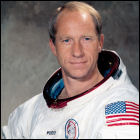 Apollo 15 astronaut Al Worden dies at the age of 88. As the mission’s command module pilot, he was the only member of Apollo 15’s crew to not walk on the moon, though he does still hold the distinction of performing the furthest spacewalk from Earth, when he retrieved film cannisters from the body of the service module, requiring him to suit up and venture outside the vehicle while it was roughly halfway on its journey from the moon back to Earth. With the other members of the crew, he was embroiled in a seemingly minor scandal involving space-flown postal covers that turned out to almost be a career-ender once the astronauts were back on Earth; he made the jump to NASA’s Ames Research Center rather than returning to the Air Force, where he had been a past instructor at the Aerospace Research Pilot School, reporting directly to Colonel Chuck Yeager. After retiring from NASA, he made an unsuccessful run for Congress in 1982, and continued promoting the space program and science education.
Apollo 15 astronaut Al Worden dies at the age of 88. As the mission’s command module pilot, he was the only member of Apollo 15’s crew to not walk on the moon, though he does still hold the distinction of performing the furthest spacewalk from Earth, when he retrieved film cannisters from the body of the service module, requiring him to suit up and venture outside the vehicle while it was roughly halfway on its journey from the moon back to Earth. With the other members of the crew, he was embroiled in a seemingly minor scandal involving space-flown postal covers that turned out to almost be a career-ender once the astronauts were back on Earth; he made the jump to NASA’s Ames Research Center rather than returning to the Air Force, where he had been a past instructor at the Aerospace Research Pilot School, reporting directly to Colonel Chuck Yeager. After retiring from NASA, he made an unsuccessful run for Congress in 1982, and continued promoting the space program and science education.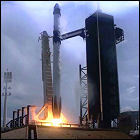 Three days after weather caused a scrub of their initial launch attempt, astronauts Douglas Hurley and Bob Behnken lift off into orbit aboard SpaceX Dragon DM-2, the second demo mission of the Crew Dragon vehicle, and the first to carry humans to space. (A previous mission, DM-1, was an uncrewed test of the Crew Dragon.) They are the first American astronauts to lift off from American soil and reach orbit since the
Three days after weather caused a scrub of their initial launch attempt, astronauts Douglas Hurley and Bob Behnken lift off into orbit aboard SpaceX Dragon DM-2, the second demo mission of the Crew Dragon vehicle, and the first to carry humans to space. (A previous mission, DM-1, was an uncrewed test of the Crew Dragon.) They are the first American astronauts to lift off from American soil and reach orbit since the 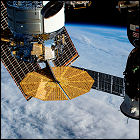 The
The  Following the first crewed test flight earlier in the year, SpaceX launches the first operational Crew Dragon flight to the International Space Station, with astronauts Michael S. Hopkins, Victor J. Glover, Sôichi Noguchi, and Shannon Walker aboard. This is also the first long-duration mission for the Crew Dragon, which will see the spacecraft remain docked to the station for several months before returning to Earth.
Following the first crewed test flight earlier in the year, SpaceX launches the first operational Crew Dragon flight to the International Space Station, with astronauts Michael S. Hopkins, Victor J. Glover, Sôichi Noguchi, and Shannon Walker aboard. This is also the first long-duration mission for the Crew Dragon, which will see the spacecraft remain docked to the station for several months before returning to Earth. Apollo 11 command module pilot Michael Collins, who remained in the command module Columbia in orbit of the moon while his crewmates, Neil Armstrong and Buzz Aldrin, landed on the moon, dies at the age of 90 after battling cancer. Upon returning to Earth, Collins opted to retire from NASA and found work within the United States government, leading to his becoming the first director of the National Air & Space Museum, a facility which had yet to open at the time he took charge of it. Collins wrote a memoir, Carrying The Fire, in 1974, one of the earliest astronaut memoirs (and the first from a member of the crew charged with making the first lunar landing). Prior to Apollo 11, he had flown with John Young aboard Gemini 10, and prior to that had distinguished careers as both a fighter pilot and a test pilot. He applied for the second group of NASA astronauts, but didn’t make the cut until NASA was recruiting its third class.
Apollo 11 command module pilot Michael Collins, who remained in the command module Columbia in orbit of the moon while his crewmates, Neil Armstrong and Buzz Aldrin, landed on the moon, dies at the age of 90 after battling cancer. Upon returning to Earth, Collins opted to retire from NASA and found work within the United States government, leading to his becoming the first director of the National Air & Space Museum, a facility which had yet to open at the time he took charge of it. Collins wrote a memoir, Carrying The Fire, in 1974, one of the earliest astronaut memoirs (and the first from a member of the crew charged with making the first lunar landing). Prior to Apollo 11, he had flown with John Young aboard Gemini 10, and prior to that had distinguished careers as both a fighter pilot and a test pilot. He applied for the second group of NASA astronauts, but didn’t make the cut until NASA was recruiting its third class.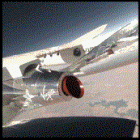 Virgin Galactic’s VSS Unity lifts off from Spaceport New Mexico on its first fully-crewed flight with passengers, including Virgin Galactic founder/owner Richard Branson, Virgin Galactic’s Beth Moses (who flew aboard a previous flight), Sirisha Bandla, and Colin Bennett, with veteran Virgin Galactic pilots David Mackay and Michael Masucci at the vehicle’s controls. The flight is suborbital only, but does earn the rookies among its crew their commercial astronaut wings. The flight was only announced at the beginning of July, where some observers interpreted the announcement as an attempt to upstage the previous announcement that Jeff Bezos’ Blue Origin would be flying a fully crewed New Shepard capsule on July 20th. Independent flight of Unity lasts approximate 14 minutes, from drop/booster ignition from its carrier aircraft to landing (total time in both air and space for those aboard is approximately 58 minutes, from takeoff of the carrier aircraft to Unity‘s touchdown on the runway). (The flight system of carrier aircraft and air-dropped spacecraft was established almost exactly 17 years earlier in
Virgin Galactic’s VSS Unity lifts off from Spaceport New Mexico on its first fully-crewed flight with passengers, including Virgin Galactic founder/owner Richard Branson, Virgin Galactic’s Beth Moses (who flew aboard a previous flight), Sirisha Bandla, and Colin Bennett, with veteran Virgin Galactic pilots David Mackay and Michael Masucci at the vehicle’s controls. The flight is suborbital only, but does earn the rookies among its crew their commercial astronaut wings. The flight was only announced at the beginning of July, where some observers interpreted the announcement as an attempt to upstage the previous announcement that Jeff Bezos’ Blue Origin would be flying a fully crewed New Shepard capsule on July 20th. Independent flight of Unity lasts approximate 14 minutes, from drop/booster ignition from its carrier aircraft to landing (total time in both air and space for those aboard is approximately 58 minutes, from takeoff of the carrier aircraft to Unity‘s touchdown on the runway). (The flight system of carrier aircraft and air-dropped spacecraft was established almost exactly 17 years earlier in 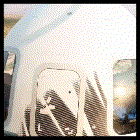 Blue Origin, the private spaceflight company founded and owned by Amazon.com founder Jeff Bezos, launches its first fully-crewed New Shepard capsule into suborbital space. Aboard are Bezos, his brother Mark Bezos, Mercury 13 astronaut candidate Wally Funk (at 82, the oldest human to have traveled in space to date), and Oliver Daemen (at 18, the youngest human space traveler to date); the vehicle is fully automatic and has no pilots (or, indeed, control systems for pilots) aboard, with the flight lasting ten minutes from liftoff to landing under parachute. This is the first crewed spaceflight launched from Blue Origin’s Texas facility. As both the New Shepard booster and crew capsule are reusable, the hardware has all been previously flown.
Blue Origin, the private spaceflight company founded and owned by Amazon.com founder Jeff Bezos, launches its first fully-crewed New Shepard capsule into suborbital space. Aboard are Bezos, his brother Mark Bezos, Mercury 13 astronaut candidate Wally Funk (at 82, the oldest human to have traveled in space to date), and Oliver Daemen (at 18, the youngest human space traveler to date); the vehicle is fully automatic and has no pilots (or, indeed, control systems for pilots) aboard, with the flight lasting ten minutes from liftoff to landing under parachute. This is the first crewed spaceflight launched from Blue Origin’s Texas facility. As both the New Shepard booster and crew capsule are reusable, the hardware has all been previously flown.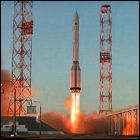 Russia launches the Nauka Multipurpose Logistics Module Upgrade component of the International Space Station. Part of the original design for the ISS, Nauka was built in time to be launched in 2007, but its addition to the station was repeatedly delayed, missing planned launch windows in 2009, 2013, 2015, 2017, 2019, and 2020. Parts of Nakua required upgrades and replacements over the years that it awaited launch, as these parts began to fail certification due to their age. (Much of the module was 14 years old before it ever made it to the launch pad.) Nakua, designed to automatically rendezvous and dock with the station, begins encountering technical problems once it is in orbit, delaying the docking maneuver. It replaces the Russian Pirs module, which becomes the first ISS module to be detached and allowed to re-enter Earth’s atmosphere.
Russia launches the Nauka Multipurpose Logistics Module Upgrade component of the International Space Station. Part of the original design for the ISS, Nauka was built in time to be launched in 2007, but its addition to the station was repeatedly delayed, missing planned launch windows in 2009, 2013, 2015, 2017, 2019, and 2020. Parts of Nakua required upgrades and replacements over the years that it awaited launch, as these parts began to fail certification due to their age. (Much of the module was 14 years old before it ever made it to the launch pad.) Nakua, designed to automatically rendezvous and dock with the station, begins encountering technical problems once it is in orbit, delaying the docking maneuver. It replaces the Russian Pirs module, which becomes the first ISS module to be detached and allowed to re-enter Earth’s atmosphere.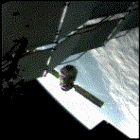 Delayed several days due to technical glitches that occurred after its launch, the Russian Nauka Multipurpose Logisitics Module Upgrade docks with the International Space Station. Some glitches continue to occur during the modules approach and docking phase, with the Russian crew members aboard the station manually intervening when necessary. After docking, however, Nauka’s thrusters begin firing, rotating the station 45 degrees off-axis, eventually exhausting its fuel supply. Once its thrusters are no longer capable of moving the station, the station is restored to its original orientation, with NASA reassuring the public that the event posed no danger to the crew. Some spacewalks will be required to fully connect Nauka’s systems to those of the rest of the station, but it is expected to become the hub of Russia’s research activity aboard the ISS.
Delayed several days due to technical glitches that occurred after its launch, the Russian Nauka Multipurpose Logisitics Module Upgrade docks with the International Space Station. Some glitches continue to occur during the modules approach and docking phase, with the Russian crew members aboard the station manually intervening when necessary. After docking, however, Nauka’s thrusters begin firing, rotating the station 45 degrees off-axis, eventually exhausting its fuel supply. Once its thrusters are no longer capable of moving the station, the station is restored to its original orientation, with NASA reassuring the public that the event posed no danger to the crew. Some spacewalks will be required to fully connect Nauka’s systems to those of the rest of the station, but it is expected to become the hub of Russia’s research activity aboard the ISS. The Federal Aviation Administration grounds the Virgin Galactic fleet following irregularities in the
The Federal Aviation Administration grounds the Virgin Galactic fleet following irregularities in the  The University Of Florida Press publishes the non-fiction book
The University Of Florida Press publishes the non-fiction book 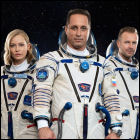 Soyuz MS-19 is launched to the International Space Station from Baikonur Cosmodrome, carrying a three-person crew (the first all-Russian Soyuz crew since Soyuz TM-30 in 2000) to a brief stay aboard the International Space Station. Cosmonaut Anton Shkaplerov, a veteran of three previous flights, commands and pilots the mission, whose other crewmembers, film director Klim Shipenko and actress Yulia Peresild, are passengers visiting the station to shoot approximately 40 minutes of footage for a movie to be released at a later date. The revival of “space tourism” aboard the ISS sparks new controversy about the topic, particularly within the Russian space program, mirroring similar controversy surrounding the burgeoning suborbital passenger spaceflight industry. Shipenko and Peresild return to Earth after 12 days aboard the ISS, catching a ride home aboard Soyuz MS-18 alongside returning ISS Commander Oleg Novitskiy; Shkaplerov remains aboard the ISS to assume command. Soyuz MS-19 will return the current ISS crew to Earth in March 2022.
Soyuz MS-19 is launched to the International Space Station from Baikonur Cosmodrome, carrying a three-person crew (the first all-Russian Soyuz crew since Soyuz TM-30 in 2000) to a brief stay aboard the International Space Station. Cosmonaut Anton Shkaplerov, a veteran of three previous flights, commands and pilots the mission, whose other crewmembers, film director Klim Shipenko and actress Yulia Peresild, are passengers visiting the station to shoot approximately 40 minutes of footage for a movie to be released at a later date. The revival of “space tourism” aboard the ISS sparks new controversy about the topic, particularly within the Russian space program, mirroring similar controversy surrounding the burgeoning suborbital passenger spaceflight industry. Shipenko and Peresild return to Earth after 12 days aboard the ISS, catching a ride home aboard Soyuz MS-18 alongside returning ISS Commander Oleg Novitskiy; Shkaplerov remains aboard the ISS to assume command. Soyuz MS-19 will return the current ISS crew to Earth in March 2022.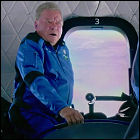 The second crewed flight of Blue Origin’s New Shepard suborbital space capsule lifts off on a ten-minute parabolic trajectory. Of major interest to the press is the presence of Star Trek actor William Shatner aboard the flight, riding in a seat donated by Blue Origin. At 90 years old, Shatner replaces previous New Shepard passenger Wally Funk as the oldest human being in space, and returns from his trip visibly moved by the experience. Along with Shatner for the ride are Audrey Powers, Blue Origin’s VP of mission and flight operations, former NASA engineer Chris Boshuizen, and Dassault Systèmes executive Glen de Vries. (The latter two each paid $250,000,000 for their seats.)
The second crewed flight of Blue Origin’s New Shepard suborbital space capsule lifts off on a ten-minute parabolic trajectory. Of major interest to the press is the presence of Star Trek actor William Shatner aboard the flight, riding in a seat donated by Blue Origin. At 90 years old, Shatner replaces previous New Shepard passenger Wally Funk as the oldest human being in space, and returns from his trip visibly moved by the experience. Along with Shatner for the ride are Audrey Powers, Blue Origin’s VP of mission and flight operations, former NASA engineer Chris Boshuizen, and Dassault Systèmes executive Glen de Vries. (The latter two each paid $250,000,000 for their seats.) Blue Origin launches the NS-19 suborbital flight aboard a New Shepard capsule, the third crewed flight of the vehicle. Passengers on the flight include Dylan Taylor, Evan Dick, Lane Bess, Cameron Bess, NFL Hall-of-Famer Michael Strahan, and Laura Shepard Churchley, the daughter of Alan Shepard, the first American astronaut to reach space. Lane and Cameron Bess are the first parent and child to fly to space on the same vehicle.
Blue Origin launches the NS-19 suborbital flight aboard a New Shepard capsule, the third crewed flight of the vehicle. Passengers on the flight include Dylan Taylor, Evan Dick, Lane Bess, Cameron Bess, NFL Hall-of-Famer Michael Strahan, and Laura Shepard Churchley, the daughter of Alan Shepard, the first American astronaut to reach space. Lane and Cameron Bess are the first parent and child to fly to space on the same vehicle.  Space shuttle astronaut Richard “Rich” Clifford, who flew three shuttle missions in the 1990s, dies at the age of 69 from complications related to Parkinson’s Disease. A Lieutenant Colonel when he retired from the U.S. Army in 1995, Clifford had been working at NASA while still with the Army, beginning his involvement with the space program in 1987. He helped to certify crew escape systems in the wake of the Challenger disaster, before moving on to assist in the design of EVA equipment in the early 90s. He flew as a mission specialist on the STS-53, STS-59, and STS-76 missions, accumulating over 600 hours in space, including an EVA lasting six hours at the Mir space station on his final flight. It was before that third mission that he was diagnosed with Parkinson’s, but he kept that diagnosis private until after the mission. He retired from NASA in 1997, but joined Boeing as its Flight Operations Manager from the construction of the International Space Station until the final shuttle mission to the ISS in 2011. He also worked with the Michael J. Fox Foundation, which funds research into Parkinson’s.
Space shuttle astronaut Richard “Rich” Clifford, who flew three shuttle missions in the 1990s, dies at the age of 69 from complications related to Parkinson’s Disease. A Lieutenant Colonel when he retired from the U.S. Army in 1995, Clifford had been working at NASA while still with the Army, beginning his involvement with the space program in 1987. He helped to certify crew escape systems in the wake of the Challenger disaster, before moving on to assist in the design of EVA equipment in the early 90s. He flew as a mission specialist on the STS-53, STS-59, and STS-76 missions, accumulating over 600 hours in space, including an EVA lasting six hours at the Mir space station on his final flight. It was before that third mission that he was diagnosed with Parkinson’s, but he kept that diagnosis private until after the mission. He retired from NASA in 1997, but joined Boeing as its Flight Operations Manager from the construction of the International Space Station until the final shuttle mission to the ISS in 2011. He also worked with the Michael J. Fox Foundation, which funds research into Parkinson’s.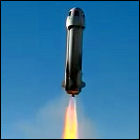 Blue Origin launches the New Shepard suborbital flight NS-20, the fourth crewed flight of the vehicle. Passengers on this flight are Marty Allen, Sharon Hagle, Marc Hagle, Jim Kitchen, George Nield, and Gary Lai. Lai is the designer of the New Shepard vehicle.
Blue Origin launches the New Shepard suborbital flight NS-20, the fourth crewed flight of the vehicle. Passengers on this flight are Marty Allen, Sharon Hagle, Marc Hagle, Jim Kitchen, George Nield, and Gary Lai. Lai is the designer of the New Shepard vehicle.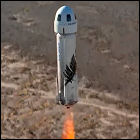 Blue Origin launches the New Shepard suborbital flight NS-21, the vehicle’s fifth crewed flight. Passengers on this flight are Evan Dick (who also flew aboard NS-19), Katya Echazarreta, Hamish Harding, Victor Correa Hespanha, Jaison Robinson, and Victor Vescovo.
Blue Origin launches the New Shepard suborbital flight NS-21, the vehicle’s fifth crewed flight. Passengers on this flight are Evan Dick (who also flew aboard NS-19), Katya Echazarreta, Hamish Harding, Victor Correa Hespanha, Jaison Robinson, and Victor Vescovo.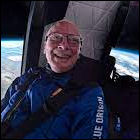 Blue Origin launches the New Shepard suborbital flight NS-22, the vehicle’s sixth crewed flight. Passengers on this flight are Coby Cotton, Mário Ferreira, Vanessa O’Brien, Clint Kelly III, Sara Sabry, and Steve Young.
Blue Origin launches the New Shepard suborbital flight NS-22, the vehicle’s sixth crewed flight. Passengers on this flight are Coby Cotton, Mário Ferreira, Vanessa O’Brien, Clint Kelly III, Sara Sabry, and Steve Young.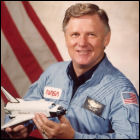 Don Lind, a veteran of the Apollo, Skylab and space shuttle eras at NASA, dies at the age of 92. Born in Midvale, Utah, his service as a U.S. Navy pilot and a degree in nuclear physics brought him to the attention of NASA, and he was a member of the agency’s fifth astronaut class, many of whom went to the moon. Lind was considered for the crew of Apollo 20 until
Don Lind, a veteran of the Apollo, Skylab and space shuttle eras at NASA, dies at the age of 92. Born in Midvale, Utah, his service as a U.S. Navy pilot and a degree in nuclear physics brought him to the attention of NASA, and he was a member of the agency’s fifth astronaut class, many of whom went to the moon. Lind was considered for the crew of Apollo 20 until 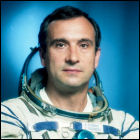 The cosmonaut who still holds the record for the longest single stay in space, Dr. Valery Polyakov, dies at the age of 80. Born in 1942, Polyakov joined the cosmonaut corps in
The cosmonaut who still holds the record for the longest single stay in space, Dr. Valery Polyakov, dies at the age of 80. Born in 1942, Polyakov joined the cosmonaut corps in  Virgin Galactic launches the Unity-25 suborbital spaceflight aboard the SpaceShipTwo-class VSS Unity. Both crew and passengers are employees of Virgin Galactic, as this is effectively a proving flight following the Federal Aviation Administration’s grounding of the Virgin Galactic fleet in 2021 after its first passenger flight. Pilots Michael Masucci and C.J. Sturckow are at the controls; Beth Moses, Luke Mays, Jamila Gilbert, and Christopher Huie are the passengers. Flights following this one will be designated “Galactic” followed by the flight number.
Virgin Galactic launches the Unity-25 suborbital spaceflight aboard the SpaceShipTwo-class VSS Unity. Both crew and passengers are employees of Virgin Galactic, as this is effectively a proving flight following the Federal Aviation Administration’s grounding of the Virgin Galactic fleet in 2021 after its first passenger flight. Pilots Michael Masucci and C.J. Sturckow are at the controls; Beth Moses, Luke Mays, Jamila Gilbert, and Christopher Huie are the passengers. Flights following this one will be designated “Galactic” followed by the flight number. Virgin Galactic launches the Galactic 01 suborbital spaceflight aboard the SpaceShipTwo-class VSS Unity. The flight is piloted by Michael Masucci and Nicola Pecile, with Italians Walter Villadei, Pantaleone Carlucci, and Angelo Landolfi, and British citizen Colin Bennett, as the passengers. Some research objectives are carried out on this flight, which was delayed from a 2021 launch date.
Virgin Galactic launches the Galactic 01 suborbital spaceflight aboard the SpaceShipTwo-class VSS Unity. The flight is piloted by Michael Masucci and Nicola Pecile, with Italians Walter Villadei, Pantaleone Carlucci, and Angelo Landolfi, and British citizen Colin Bennett, as the passengers. Some research objectives are carried out on this flight, which was delayed from a 2021 launch date.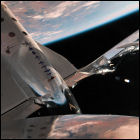 Virgin Galactic launches the Galactic 02 suborbital spaceflight aboard the SpaceShipTwo-class VSS Unity. The flight is piloted by CJ Sturckow and Kelly Latimer, with Birgin Galactic’s Beth Moses aboard as the astronaut instructor. The passengers are space tourists Jon Goodwin, Keisha Schahaff, and Anastatia Mayers. Goodwin is the first space traveler to fly after being diagnosed with Parkinson’s Disease.
Virgin Galactic launches the Galactic 02 suborbital spaceflight aboard the SpaceShipTwo-class VSS Unity. The flight is piloted by CJ Sturckow and Kelly Latimer, with Birgin Galactic’s Beth Moses aboard as the astronaut instructor. The passengers are space tourists Jon Goodwin, Keisha Schahaff, and Anastatia Mayers. Goodwin is the first space traveler to fly after being diagnosed with Parkinson’s Disease. Former test pilot, Gemini and Apollo astronaut Jim Lovell dies at the age of 97. A U.S. Navy pilot, Lovell had applied to join NASA during the agency’s initial search for the Mercury astronauts, but was sidelined from selection due to medical test results, only to be brought into the space program when new astronauts were recruited for the Gemini program. Lovell was the pilot of
Former test pilot, Gemini and Apollo astronaut Jim Lovell dies at the age of 97. A U.S. Navy pilot, Lovell had applied to join NASA during the agency’s initial search for the Mercury astronauts, but was sidelined from selection due to medical test results, only to be brought into the space program when new astronauts were recruited for the Gemini program. Lovell was the pilot of